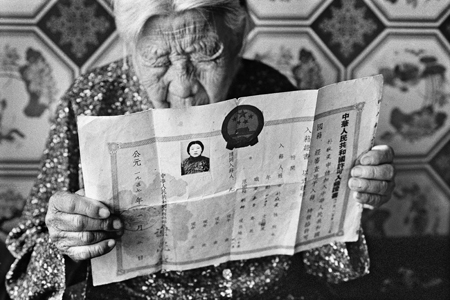
Photo exhibition shows sorrow of comfort women

Tears started to run down faces as the photographs were finally unveiled in Seoul last week.
Photographer Ahn Se-hong is showcasing a collection of his work that has stirred strong emotions in both Japan and Korea — pictures of Korean women in China who are former sex slaves of the Japanese Imperial army. The photographer visited them in 2001 and captured moments of their daily lives.
The exhibition is part of a project titled “Layer by Layer,” designed to tell the world of the agony and torture that the women were forced to endure. It is also an attempt to resolve their deep sense of sorrow by expressing their deepest held emotions. The title conveys the profound sense of layered resentment that has grown over 70 years.
“I dedicate this exhibition to the victims living in very poor conditions,” said Ahn at Ryugaheon gallery on Tuesday.
About 70 years ago, young Korean women were forced to get on trains to China, trembling in fear before the guns and swords of the Japanese military. A few days later, they were thrown into an area of barren earth and dragged to Wunnam in China where their lives were completely ruined. There, they were abused and exploited in brothels as sex slaves to the Japanese military. Even after Korea became independent from Japanese rule in 1945, these women were not able to return to their home country. So, many of them, scarred mentally and physically, have never married or had children. After a group of Korean victims spoke out in the early 1990s, Japan acknowledged the wartime slavery in a statement issued in 1993 and provided a small fund for compensation.
Each of the photos has the details of the victims including their name, current location, date of birth, hometown and location of the brothel where they were forced to remain. It is shocking to see that some of them still live in these same areas. Ahn said it was because they had “no idea where they were from in the beginning.” All the photos certainly reflect their present and past lives; revealing their broken hearts expressed tearful eyes, deeply furrowed brows and belongings that are old and stained.
The photographer also said that he went through tough times when the exhibition was held in Japan in June this year.
Nikon originally accepted the exhibition earlier this year but suddenly cancelled last month after receiving protests from right-wing groups in Japan. “It was actually one of Nikon’s shareholder firms, Mitsubishi that protested against it. I sued in order to force Nikon to hold the exhibition and Judge Yasushi Itami finally ruled in my favor,” said the photographer. As a result, about 7,900 people in Japan visited the exhibition.
Born in Gangwon Province in 1971, Ahn grew up and was educated in Seoul. He has long been taking documentary photos on topics such as the disabled and human rights. He also has held a number of solo and group exhibitions in Japan and Korea since 1998 and is currently working on a project that compares Korean shamanism to other forms practiced in Asia.
“I am planning to take photographs of comfort women living in other countries. Furthermore, I am going to collect the works of other photographers and hold an exhibition at galleries in big cities such as London, Paris, Berlin and Tokyo in 3 years time,” Ahn said.
The exhibition runs through Aug. 26 at Ryugaheon, chiefly a photography gallery in Seoul. For more information, visit www.ryugaheon.com. <The Korea Times/Rachel Lee>


